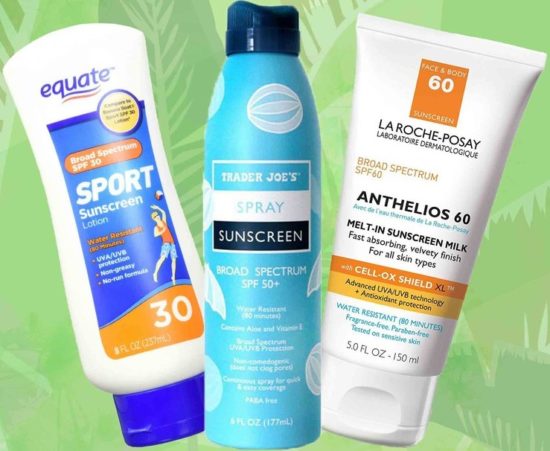
For starters, the most prominent thing on the label is SPF, which stands for sun protection factor. SPF provides a relative measure of how long sunscreen protects your skin from the damaging ultraviolet rays of the sun.
In recent years, you might have noticed the phrase “broad spectrum” start to appear on sunscreen labels as well — and it means that the product protects you from the aforementioned ultraviolet rays that are covered by SPF and a variant that are not (the first is known as UVB and the second is known as UVA).
Effects of the Sun
According to Dr. Lawrence E. Gibson, a dermatologist at the Mayo Clinic, UVA rays can prematurely age your skin, causing wrinkles and age spots, while UVB rays cause sunburns. Too much exposure to either type of ray can cause skin cancer.
While sunscreen will protect you from the most harmful rays, you need to use it generously.
Apply it 15 minutes before you step outside and then reapply every couple of hours, but more frequently than that if you sweat or swim. And don’t forget to apply it to your ears, neck, tops of your feet and even your scalp (if your hair is thinning).
Other Ways to Protect Yourself
And that’s not enough to get you out of the woods — or make it the sun. Dr. Gibson recommends you minimize or altogether avoid sun exposures during the peak hours between 10 a.m. to 2 p.m. — even on overcast days.
He also recommends you wear protective clothing and accessories, including a wide-brimmed hat and sunglasses.
You can even find sporty clothing with built in SPF. But don’t just take the manufacturer’s word for it.
Labels Might Mislead
Even sunscreens don’t always live up to the amount of SPF they claim on their labels, according to Consumer Reports, which recently evaluated 73 different sunscreens in order to arrive at a list of the best ones.
The reviewers found that about one third of the sunscreens turned out to have half the potency of the SPF listed on their label.
Consumer Reports recommends that you choose a broad spectrum sunscreen with an SPF of at least 30.
The Best Sunscreen for 2018
To help point you in the right direction, here are the top three lotions and top two spray or stick format sunscreens according to Consumer Reports’ evaluations:
- BullFrog Land Sport Quik Gel SPF 50 ($8.50, or $1.70 cents an ounce)
- La Roche-Posay Anthelios SPF 60 Melt-in Sunscreen Milk ($36, or $7.20 an ounce)
- Target’s Up & Up Kids Sunscreen Stick SPF 55 ($8, or $6.67 an ounce)
- Trader Joe’s Spray Sunscreen Broad Spectrum SPF 50+ ($6, or $1 an ounce)
- Walmart’s Equate Sport Lotion SPF 50 ($5, or 63 cents an ounce)
Natural Sunscreens
Apparently people have been turning to so-called natural sunscreens, out of concern that regular sunscreens contain chemicals that might be contributing to the bleaching of coral reefs.
In fact, the most prevalent of these, oxybenzone has created enough of a concern for Hawaii to ban sunscreens containing the ingredient starting in 2021.
If you’re worried about contributing to coral reef bleaching, wear a tee-shirt or other cover-up when you go in the water and you’ll cut your need for sunscreen at least in half.
Use on Kids
Natural sunscreens are also recommended for use on children; that’s the market for Consumer Reports’ top choice in the natural category: California Kids #Supersensitive Lotion SPF 30+ ($20 a package, or $6.90 an ounce).
Consumer Reports recommends you not use spray sunscreens on children — or at the very least if you do, spray it into your hand and then apply.
The website also suggested that pregnant women not use sunscreens that contain retinol palmitate or retinyl palmitate because direct sunlight makes these chemicals potentially carcinogenic.
Still, that might be trading one carcinogen for another — since the rays of the sun are liked to most skin cancers.
You can always avoid both problems by covering up your skin when you go in the sun. It might make you sweat more (when you’re not in the water) but that probably beats getting cancer.
Readers, what kind of sunscreen do you use (or not)?
If you enjoy reading our blog posts and would like to try your hand at blogging, we have good news for you; you can do exactly that on Saving Advice. Just click here to get started.
Read More
- Will Heatwaves and Rainstorms Set New Records This Summer?
- Protect Yourself Against Mosquitoes and Tick Bites This Summer
- Summer Road Trip Planning: Campgrounds, Trailer Parks, or Hotels?
- How to Negotiate a Summer Home Rental
- 10 Ways to Save Money When Visiting the Beach
- A Summer Savings Plan to Get You Ahead
- Inexpensive Summer Snacks for the Neighborhood
- Summer Fun on a Budget
- 5 Great Getaway Ideas for Memorial Day Weekend
- What’s Open on Memorial Day 2018
- How to Choose the Best Summer Camp for Your Child
- Summer Is Coming: No and Low Cost Entertainment for Kids
- Grills – Save Big Now on Summer Fun
- The Ocean Is Warming Faster Than We Thought
- Climate Change Warning: Gulf Stream Currents at 1,600 Year Low
Jackie Cohen is an award winning financial journalist turned turned financial advisor obsessed with climate change risk, data and business. Jackie holds a B.A. Degree from Macalester College and an M.A. in English from Claremont Graduate University.
Comments